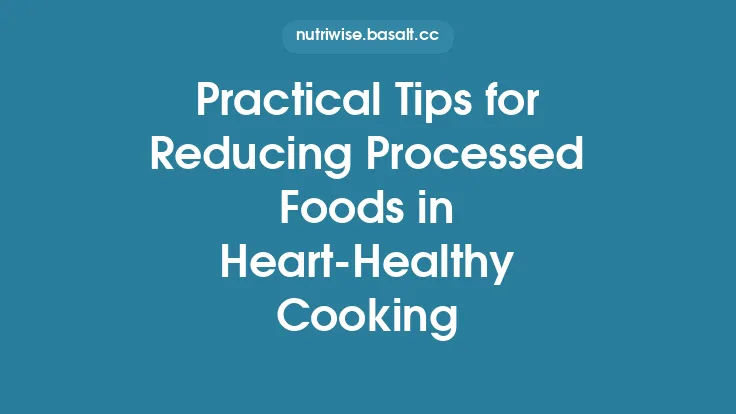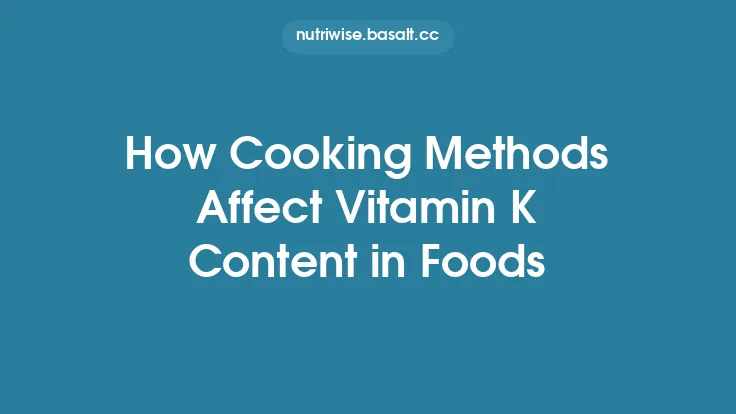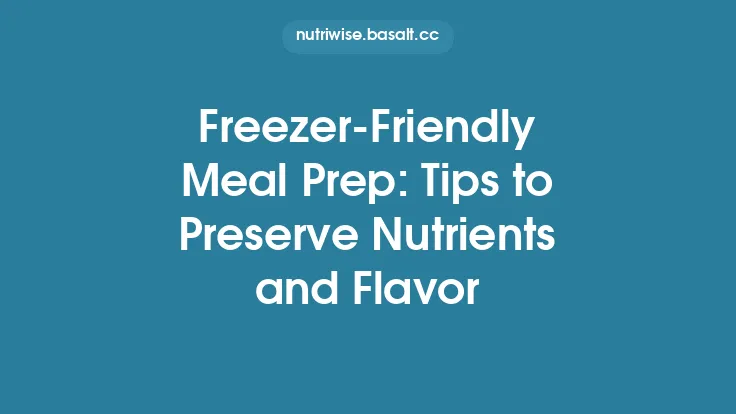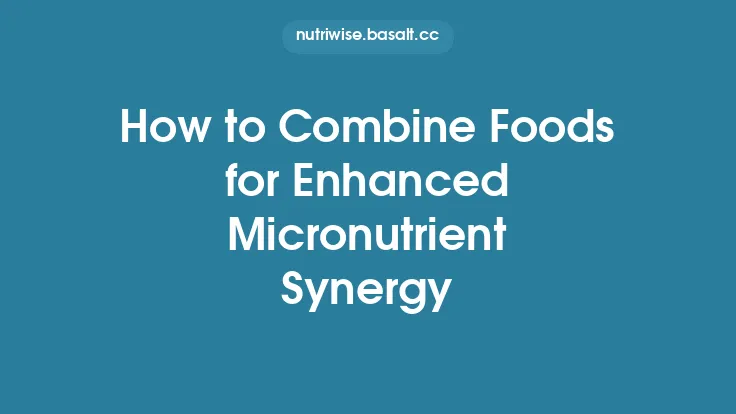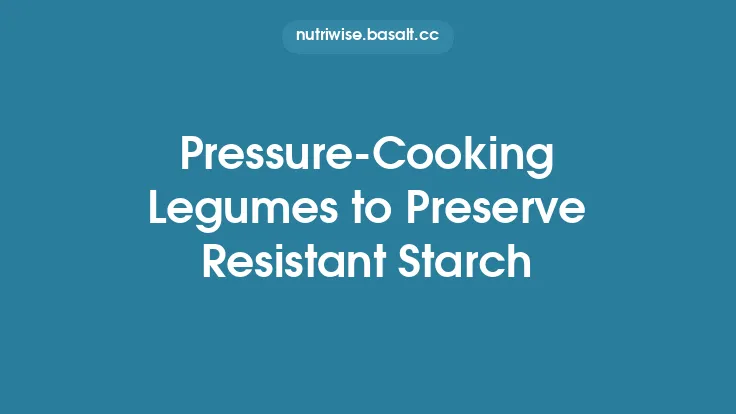Zinc is a trace mineral that remains relatively stable during most cooking processes, yet the way we handle, store, and prepare foods can have a measurable impact on the amount that ultimately reaches our plates. By paying attention to factors such as cooking temperature, water usage, and the presence of compounds that bind zinc, home cooks can maximize the nutrient’s retention in everyday meals. Below are evidence‑based strategies for preserving zinc across a variety of common food groups, from animal proteins to plant‑based staples.
Understanding Zinc Stability in Food
Zinc is a heat‑stable element; it does not break down or evaporate like some vitamins when exposed to high temperatures. However, zinc can be leached into cooking water, become bound to antinutrients (e.g., phytates, oxalates), or be lost through excessive trimming and processing. The key to retention lies in minimizing these loss pathways while enhancing the mineral’s bioavailability.
- Leaching: Water‑soluble zinc can migrate from the food matrix into the cooking liquid. The extent of leaching depends on the surface area exposed, cooking duration, and the volume of liquid used.
- Binding: Phytates (found in whole grains, legumes, nuts, and seeds) and oxalates (present in certain leafy greens) form insoluble complexes with zinc, reducing its absorption in the gut.
- Physical loss: Trimming fatty or connective tissue from meat can remove zinc‑rich portions, especially in organ meats where zinc concentrations are highest.
General Cooking Principles for Zinc Retention
- Use Minimal Water: When boiling or simmering, keep the water volume just enough to cover the food. Excess water increases the chance of zinc leaching.
- Shorten Cooking Times: Over‑cooking does not degrade zinc but can increase leaching. Opt for methods that cook foods quickly (e.g., steaming, stir‑frying, pressure cooking).
- Capture Cooking Liquids: If a recipe calls for boiling vegetables or legumes, repurpose the broth as a soup base, sauce, or gravy to reclaim any dissolved zinc.
- Avoid Excessive Trimming: For meat and poultry, retain as much of the lean tissue as possible. When removing skin, consider using it in stocks where zinc can be extracted.
- Control pH: Slightly acidic environments (pH 5–6) can help keep zinc in solution and reduce binding to phytates. Adding a splash of lemon juice or a modest amount of vinegar during cooking can be beneficial.
Animal‑Based Foods
Meat, Poultry, and Game
- Quick Sear Followed by Low‑Heat Finish: Searing meat at high temperature for 2–3 minutes creates a flavorful crust while preserving internal moisture. Finish the cooking at a lower temperature (e.g., oven roasting at 300 °F/150 °C) to avoid prolonged exposure to liquid that could leach zinc.
- Steaming Over Boiling: For delicate cuts such as chicken breast, steaming retains moisture and eliminates the need for a cooking liquid, thereby preserving zinc.
- Utilize Bone‑Based Stocks: Bones, especially from beef and lamb, are rich in zinc. Simmer them gently for 4–6 hours; the resulting stock captures zinc that would otherwise be lost if the bones were discarded.
Seafood
- Gentle Poaching: Poaching fish in a shallow pan with a modest amount of broth or wine (just enough to cover the fillet) for 5–8 minutes retains zinc while preventing leaching into a large volume of water.
- Grilling and Broiling: Direct dry‑heat methods that do not involve water are ideal for shellfish and fish, as they keep zinc locked within the muscle tissue.
- Avoid Over‑Salting: High salt concentrations can draw out moisture and minerals, including zinc, from seafood during brining.
Plant‑Based Sources
Legumes (Beans, Lentils, Chickpeas)
- Soak and Rinse: Soaking legumes for 8–12 hours reduces phytate content, which otherwise binds zinc. Discard the soaking water and rinse thoroughly before cooking.
- Pressure Cooking: A pressure cooker reduces cooking time dramatically (e.g., 10 minutes for lentils) and limits water exposure, thereby preserving zinc.
- Fermentation: Fermented legume products (e.g., tempeh, miso) have lower phytate levels, enhancing zinc bioavailability. When cooking tempeh, a brief steam (5–7 minutes) is sufficient.
Whole Grains (Quinoa, Brown Rice, Oats)
- Rinse Sparingly: Rinsing removes surface dust but excessive washing can leach water‑soluble zinc. A quick rinse (30 seconds) is adequate.
- Cook with Reduced Liquid Ratio: Use a 1.5:1 water‑to‑grain ratio instead of the typical 2:1 for brown rice; this reduces leaching while still achieving proper texture.
- Toasting Before Cooking: Lightly toasting grains (e.g., 5 minutes in a dry skillet) can deactivate some antinutrients, improving zinc availability.
Nuts and Seeds
- Roasting at Moderate Temperatures: Roast nuts and seeds at 300 °F (150 °C) for 10–15 minutes. Higher temperatures can cause slight mineral loss through volatilization of bound compounds, while low temperatures may not sufficiently reduce antinutrients.
- Soaking for Sprouted Variants: Soaking almonds, walnuts, or pumpkin seeds for 4–6 hours, followed by a short drying period, initiates sprouting, which reduces phytate levels and improves zinc absorption.
Vegetables Rich in Zinc
- Leafy Greens (Spinach, Kale): Oxalates in these greens can bind zinc. Blanching briefly (1–2 minutes) in a small amount of water, then shocking in ice water, reduces oxalate content without significant zinc loss. Use the blanching water in soups or sauces to reclaim any leached zinc.
- Cruciferous Vegetables (Broccoli, Brussels Sprouts): Steam rather than boil to keep zinc within the florets. A steaming time of 5–7 minutes preserves texture and nutrient density.
- Mushrooms: Sauté mushrooms in a small amount of oil or butter over medium heat. The limited liquid prevents leaching, and the fat aids in the absorption of fat‑soluble nutrients that may accompany zinc.
Combining Foods to Enhance Zinc Bioavailability
While the focus here is on cooking techniques, pairing zinc‑rich foods with certain ingredients can further protect zinc from binding:
- Acidic Additions: A squeeze of lemon juice or a dash of tomato puree during cooking can lower pH, reducing phytate‑zinc complex formation.
- Fermented Condiments: Adding a spoonful of sauerkraut or kimchi to grain‑based dishes introduces lactic‑acid bacteria that break down phytates.
- Minimal Dairy Pairing: Calcium can compete with zinc for absorption. When cooking zinc‑rich meals, limit the addition of high‑calcium dairy products until after cooking (e.g., sprinkle cheese on top after the dish is finished).
Practical Kitchen Tips
| Tip | Why It Works | How to Implement |
|---|---|---|
| Cook in a Covered Pot | Traps steam, reduces need for excess water | Use a tight‑fitting lid; add just enough liquid to generate steam |
| Reuse Cooking Water | Recovers leached zinc | Turn broth into soups, gravies, or risottos |
| Batch Soak Legumes | Lowers phytate content | Soak large quantities in a refrigerator; store the soaking water for compost |
| Use Cast‑Iron Skillets | Small amounts of zinc can leach from the cookware, adding to the dish | Pre‑season the pan; avoid acidic foods that accelerate leaching |
| Avoid Over‑Processing | Trimming removes zinc‑dense tissue | Keep skins (when edible) and connective tissue; use whole cuts |
Summary
Preserving zinc during cooking is less about protecting the mineral from heat and more about managing water, antinutrient interactions, and food handling practices. By:
- minimizing water exposure,
- shortening cooking times,
- capturing and reusing cooking liquids,
- employing soaking, sprouting, and fermentation to reduce phytates,
- and pairing zinc‑rich foods with mild acids,
home cooks can ensure that the zinc content of their meals remains as high as possible. These evergreen techniques apply across a wide range of foods—meats, seafood, legumes, grains, nuts, seeds, and vegetables—making them valuable tools for anyone seeking to maintain optimal micronutrient intake through everyday cooking.
